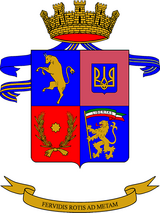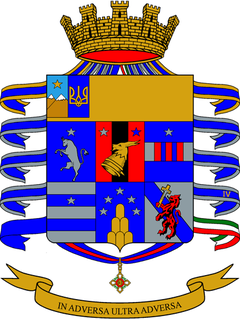
The 4th Alpini Paratroopers Regiment is a Ranger-type special forces regiment of the Italian Army, specializing in mountain combat. The regiment is one of three regiments of the Army Special Forces Command. The regiment is a unit of the Italian Army's mountain infantry speciality, the Alpini, which distinguished itself in combat during World War I and World War II. The 4th Alpini Paratroopers Regiment is one of the most decorated units of the Italian Army, although its two Gold Medals of Military Valour were awarded to the regiment's currently inactive Alpini Battalion "Aosta", respectively the currently active Skiers Battalion "Monte Cervino".

The 1st Alpine Division "Taurinense" was a division of the Royal Italian Army during World War II, which specialized in mountain warfare. The Alpini that formed the division are a highly decorated and elite mountain corps of the Italian Army consisting of both infantry and artillery units. Today, the traditions and name of the 1st Alpine Division "Taurinense" are carried on by the Alpine Brigade "Taurinense". The headquarters of the division was in the city of Turin and the majority of its soldiers were drafted from the surrounding Province of Turin — therefore the division was named "Taurinense" for the Roman name of the city of Turin Augusta Taurinorum.
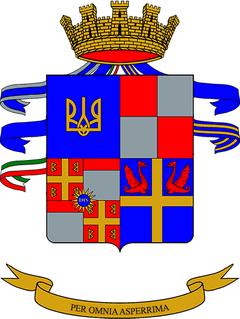
The 2nd Engineer Regiment is a military engineer regiment of the Italian Army based in Trento in Trentino. Founded in 1860 it is currently the oldest engineer regiment of the Italian Army. Since 1954 it has been part of the 4th Alpine Army Corps and therefore has a strong association with the army's mountain infantry corps, the Alpini, with which the regiment shares the distinctive Cappello Alpino. Today the regiment is the engineer unit of the Alpine Brigade "Julia" and specializes in mountain combat.
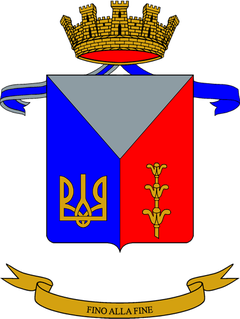
The 32nd Engineer Regiment is a military engineer regiment of the Italian Army based in Fossano in Piedmont. Raised on 24 September 2004 it is the youngest engineer regiment of the Italian Army and specializes in mountain combat. Its name was chosen to commemorate the XXXII Sapper Battalion, which fought in the Western Desert Campaign of World War II, while the regiment's only battalion, the XXX Sappers Battalion, fought in the Italian campaign on the Eastern Front. Since its reformation on 1 September 2002 as 32nd Engineer Battalion the unit has been part of the Alpine Brigade "Taurinense". Together with the other units of the Taurinense the regiment shares the right to wear the distinctive Cappello Alpino.

The Mechanized Brigade "Aosta" is a mechanized infantry brigade of the Italian Army based on the island of Sicily. The Brigade is one of the oldest of the Italian Army and the name connects the brigade to its original area of recruitment the Aosta Valley and therefore the brigade's coat of arms is modeled after the coat of arms of Aosta. The brigade is part of the Division "Acqui".

The 3rd Cavalry Division "Principe Amedeo Duca d'Aosta" was a Cavalry or "Celere" (Fast) division of the Royal Italian Army during World War II. The division was formed in 1934, and during World War II was mobilized in June 1940. As a cavalry division it took part in the Invasion of Yugoslavia and was part of the Italian Expeditionary Corps in Russia. Annihilated during the Red Army's Operation Little Saturn in December 1942, the survivors returned to Italy in spring 1943.

The 8th Paratroopers Engineer Regiment "Folgore" is the Italian Army's airborne combat engineer unit. The regiment provides close combat support to the Paratroopers Brigade "Folgore". The unit is fully professional, able to deploy with on short notice and capable to fight in every environment. In peacetime it is available to support the civil protection, be it for disposing explosive remnants of war or in case of natural disasters.
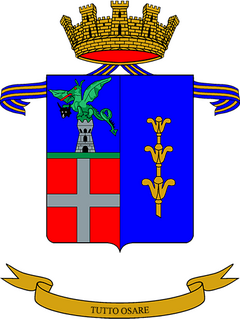
The 21st Engineer Regiment is a military engineer regiment of the Italian Army based in Caserta in Campania. Today the regiment is the engineer unit of the Bersaglieri Brigade "Garibaldi".

The 11th Engineer Regiment is a military engineer regiment of the Italian Army based in Foggia in Apulia. Today the regiment is the engineer unit of the Mechanized Brigade "Pinerolo".

The 10th Engineer Regiment is a military engineer regiment of the Italian Army based in Cremona in Lombardy. Today the regiment is the engineer unit of the 132nd Armored Brigade "Ariete".

The 5th Engineer Regiment is a military engineer regiment of the Italian Army based in Macomer in Sardinia. Today the regiment is the engineer unit of the Mechanized Brigade "Sassari".

The 4th Engineer Regiment is a military engineer regiment of the Italian Army based in Palermo in Sicily. Today the regiment is the engineer unit of the Mechanized Brigade "Aosta".

The 3rd Engineer Sappers Regiment is a military engineer regiment of the Italian Army based in Udine in Friuli Venezia Giulia. Today the regiment is the engineer unit of the Cavalry Brigade "Pozzuolo del Friuli".

The Engineer Command in Rome-Cecchignola commands the specialized engineer regiments of the Italian Army and it is tasked with training of all officers and troops destined for engineer units, as well as with both doctrinal and operational tasks.

The 6th Pioneer Regiment is a military engineer regiment of the Italian Army based in the Cecchignola quarter of Rome. Today the regiment is administratively assigned to the army's Engineer Command and the army's sole pioneer unit, whose focus, unlike the army's other engineer units, is on rear area construction tasks.

The 2nd Bridge Engineer Regiment is a military engineer regiment of the Italian Army based in Piacenza in the Emilia Romagna. Today the regiment is administratively assigned to the army's Engineer Command and the army's sole unit focusing on operational level river crossings.

The Logistic Regiment "Aosta" is a military logistics regiment of the Italian Army based in Palermo in Sicily. The regiment was formed on 1 June 2015 and is the logistic unit of the Mechanized Brigade "Aosta".

The 82nd Infantry Regiment "Torino" is an active unit of the Italian Army based in Barletta in Apulia. The regiment is part of the Italian army's infantry corps and operationally assigned to the Mechanized Brigade "Pinerolo".

The 66th Airmobile Infantry Regiment "Trieste" is an active unit of the Italian Army based in Forlì in the Emilia-Romagna. The regiment is part of the Italian army's infantry corps and operationally assigned to the Airmobile Brigade "Friuli". The regiment is the only airmobile infantry unit of the Italian Army.
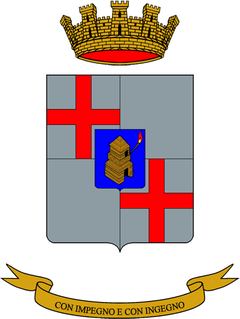
The 32nd Signal Regiment is a national support signals regiment of the Italian Army based in Padua in Veneto and Turin in Piedmont. Today the regiment is administratively assigned to the army's Signal Command and operates the army's signal network in Northern Italy.
